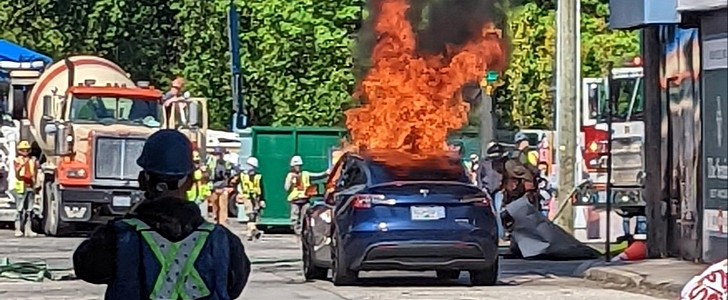The fire that engulfed a Tesla Model Y in May in Vancouver made international headlights, along with other reports about Tesla fires. Transport Canada has released a preliminary report showing that the high-voltage battery was not to blame for that particular fire.
Electric vehicle fires, and especially those involving Tesla cars, get a lot of media attention. Despite the emotional response, statistics consistently show that electric vehicle fires are less common than those reported on combustion-engine cars. Following the Chevrolet Bolt extended drama, most people instantly consider the Li-Ion battery as the cause of an EV fire. It is true, Li-Ion cells are sometimes unstable, but battery fires are still rare occurrences.
Back in May, a Tesla Model Y erupted in flames in Vancouver. The news quickly traveled around the world, fueled by the fact that the power was cut off and the driver remained trapped inside. Luckily, he escaped after breaking the car’s window. Soon after the incident, an investigation was started, trying to find out what caused the fire.
Many suspected the high-voltage battery could be the culprit. However, the Vancouver fire was slow to spread, and the fire department could put it out rather quickly. Usually, this is not the case with battery fires like those that crippled the Chevrolet Bolt. They rage violently and are notoriously hard to extinguish, sometimes requiring the vehicle to be submerged underwater.
Transport Canada has confirmed with Drive Tesla that the fire was indeed caused by something else. The conclusion came after the Model Y was thoroughly analyzed by their own inspectors and contracted investigators, representatives from Tesla, officials from the provincial insurer, and a Fire Department investigator. That is good news, as the Li-ion battery in Tesla vehicles appears to be safe. The bad news is that the exact cause of the fire was not yet determined.
The investigators have determined thus far that the fire started in the left half of the dashboard. According to Transport Canada, this is where the left-side Body Control Module resides. This mirrors what the car owner told Drive Tesla in an interview back in May, that he first noticed smoke coming out of the driver’s side vent.
The investigation continues, and Transport Canada says that the area of interest is under intense scrutiny. Several components under the instrument panel have been removed for an in-depth analysis. These include the said Body Control Module and the steering column assembly. The car’s computer was also removed, as it may contain valuable information about the malfunction that contributed to the fire.
Back in May, a Tesla Model Y erupted in flames in Vancouver. The news quickly traveled around the world, fueled by the fact that the power was cut off and the driver remained trapped inside. Luckily, he escaped after breaking the car’s window. Soon after the incident, an investigation was started, trying to find out what caused the fire.
Many suspected the high-voltage battery could be the culprit. However, the Vancouver fire was slow to spread, and the fire department could put it out rather quickly. Usually, this is not the case with battery fires like those that crippled the Chevrolet Bolt. They rage violently and are notoriously hard to extinguish, sometimes requiring the vehicle to be submerged underwater.
Transport Canada has confirmed with Drive Tesla that the fire was indeed caused by something else. The conclusion came after the Model Y was thoroughly analyzed by their own inspectors and contracted investigators, representatives from Tesla, officials from the provincial insurer, and a Fire Department investigator. That is good news, as the Li-ion battery in Tesla vehicles appears to be safe. The bad news is that the exact cause of the fire was not yet determined.
The investigators have determined thus far that the fire started in the left half of the dashboard. According to Transport Canada, this is where the left-side Body Control Module resides. This mirrors what the car owner told Drive Tesla in an interview back in May, that he first noticed smoke coming out of the driver’s side vent.
The investigation continues, and Transport Canada says that the area of interest is under intense scrutiny. Several components under the instrument panel have been removed for an in-depth analysis. These include the said Body Control Module and the steering column assembly. The car’s computer was also removed, as it may contain valuable information about the malfunction that contributed to the fire.
Update: driver kicked out the window, not the construction workers. Car is a write off - shocker https://t.co/J5EoRtSsDh
— Mjarchie (@Mjarchie1) May 21, 2022






